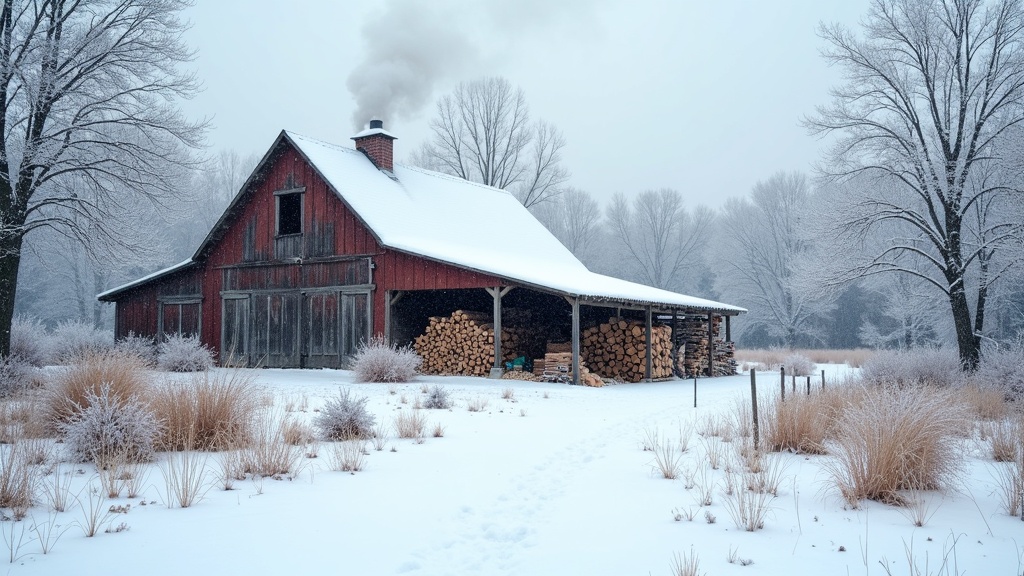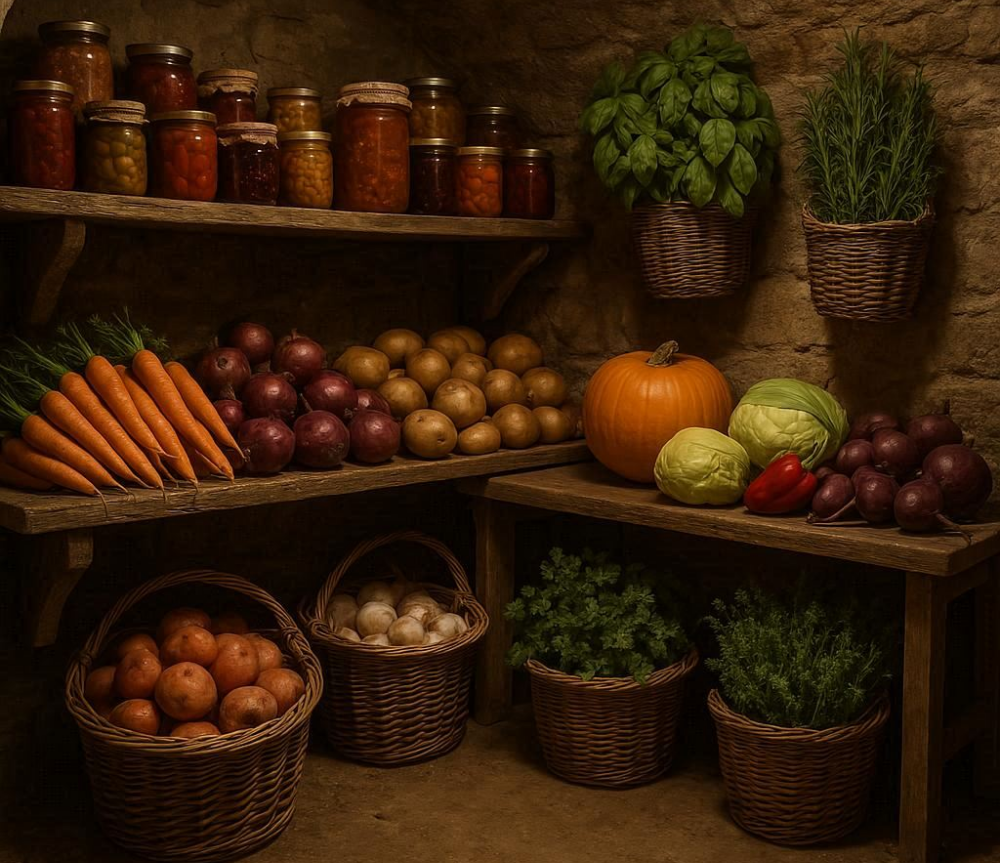Getting your homestead winter-ready isn’t just about cozy sweaters and hot cocoa; it’s about making sure your garden, animals, tools, and house don’t fall apart the second the first snow hits. Here’s the short list:
- Garden check-up: Harvest what’s left, yank the dead plants (don’t compost the sick ones), and tuck your soil in with leaves or mulch. Think of it as a blanket for dirt.
- Save the good stuff: Collect seeds, order next year’s catalog, and rescue tender plants before Jack Frost turns them into plant popsicles.
- Animal TLC: Stockpile feed, keep water from turning into ice cubes, and fluff up shelters with fresh bedding. If you’ve got more mouths to feed than you want through winter, now’s the time for… well, “population control.”
- Home prep: Hunt down drafts like a detective, seal them up, and insulate water lines before they freeze into garden hoses of despair.
- Tools & firewood: Clean, oil, and store your gear so it doesn’t rust into uselessness. Stack plenty of wood if you heat with it; future you will thank you.
- Food stash: Can it, dry it, jam it, or jelly it. Then organize that pantry so you know whether you’ve got enough beans to survive the apocalypse, or just until spring.
Winter’s coming whether we like it or not, but a little prep now means less panic later. And hey, when the snow falls, you’ll actually get to enjoy that cocoa.
Start with the Garden: Harvest, Clean Up, and Protect the Soil
The tail end of fall is really important for homestead gardens. If you leave old crops to rot you’re inviting critters, mold, and pests that’ll make trouble for next season. I always make sure to harvest whatever’s left, even if it’s just a handful of straggler beans or late greens. Anything healthy goes in the kitchen or the root cellar, while dead or diseased plants need pulling and removing. Compost the good, trash the sick stuff so you don’t spread a problem.
Once you’ve cleared the beds, it’s time to tuck in the soil. I like to toss on a nice layer of leaves or straw. Mulch helps keep the ground from eroding, stops weeds from popping up, and gives worms and microbes something to munch on over winter. Think of it as tucking your dirt in for a long nap.
Seed Saving and Planning for Spring
This is the fun part; collecting seeds from your best plants and stashing them somewhere cool and dry. I’ve always found that homegrown seeds handle my little micro-climate better than anything I buy. Just make sure they’re truly dry before sealing them up so you don’t end up with fuzzy, moldy seeds in spring.
I also use this time to order new catalogs and sketch out rough ideas for next year’s plot. Looking at seed catalogs in the middle of winter? That’s one of my favorite things.
Don’t forget any indoor plants or tender perennials. Pot them up and bring them inside before a hard frost takes them down.
Stashing seeds and planning a new plot for the next year keeps you in a gardener’s mindset even while the landscape is frozen. Winter is a good time to dig into resources, learn new methods, or exchange ideas with other homesteaders—sometimes you stumble upon ideas that totally change your approach in the spring.
Animal Care: Shelter, Stockpile, and Water Management
Animals will tell you when the weather’s too much; they huddle up, shiver, or protest in their own grumpy ways. I always start by checking shelters and patching holes or leaks. Adding fresh bedding like straw or wood shavings helps keep them warm and dry. If you keep chickens, ventilation is still needed, but wind and drafts should be avoided.
- Feed: Stock up on animal feed before roads get icy or stores sell out. I buy a little extra in case winter drags on.
- Water: Chopping ice out of buckets is nobody’s idea of a good time. Heated waterers or insulated buckets can be a lifesaver if the budget allows. At the very least, check water sources twice a day.
- Population: Fall is decision time; are you keeping all your animals through winter? If you raise meat birds, pigs, or other livestock for food, now’s when I usually downsize the flock to match the amount of feed and shelter I’m willing to provide.
It’s also a good time to check in with local farmers about hay and bedding supplies. Sometimes, sharing delivery costs or planning ahead makes things go much smoother for everyone through the tougher months.
Winterizing Your Home and Outbuildings
I spend a whole afternoon tracking down drafts in my house: the cracks around doors and windows, the little gaps where pipes come in, all those sneaky spots that leak warm air. Weatherstripping, caulk, or even a rolled-up towel can help.
- Water Troubles: Burst pipes are a winter classic, but not the kind of nostalgia anyone wants. Exposed water lines need wrapping, foam insulation, or heat tape. Same goes for outside spigots; drain and disconnect hoses, or cover them up tight.
- Roof & Gutters: Clean gutters mean no ice dams. Giving the roof a quick once-over for missing shingles or loose flashing saves headaches later.
Don’t forget about garages or sheds—animals sometimes look for shelter there too. Making sure there’s nothing valuable in easy reach of wildlife and pests is just as important as tucking in the house itself.
Tools, Gear, and Firewood: Store It or Lose It
I’ve learned the hard way that leaving tools out in the elements leads to rust, stuck shovels, and broken handles. So after the last big project, I give my tools a brisk scrub, dry them well, and run a bit of oil over metal surfaces. Bigger machines like mowers or tillers get drained of fuel or run dry, and then tucked away in a shed or barn.
If you use wood heat, stacking up firewood early is essential. I stack mine off the ground and cover the top with a tarp, but leave the sides open for airflow to keep it dry. Lugging wood through waist-deep snow is not anybody’s idea of a good time, so having a stash close to the house is super handy. It’s also a nice boost to stock up on kindling and save a bin of dry scraps for days when lighting the stove seems extra tough.
Food Storage and Pantry Organization

All that summer and fall preserving pays off now. I can, freeze, ferment, and dry what I can, and then re-organize the pantry so there’s a sense of what needs to be used first. Grouping things by type and using clear containers makes it easier to see how much I really have.
Root cellars, even if it’s just a cold part of the basement or an outdoor dry box, are great for potatoes, carrots, onions, and apples. Checking these every few weeks for rot keeps the whole batch from spoiling. Keeping an eye out for rodents in stored grains is important. Sometimes just elevating bins or using metal containers gives you an extra layer of protection.
Winter is also an awesome time to test new recipes that use up items you put away and rotate through your stash. This keeps things from getting stale, both in your kitchen and on your plate, until the garden starts popping again.
Common Pitfalls to Watch For During Winter Prep
- Forgetting to Mulch: Bare soil in winter can compact and lose nutrients fast.
- Not Checking Weather Stripping: Even a tiny gap around a door can jack up the heating bill.
- Ignoring Gutter Clean-up: Clogged gutters create icy messes that damage the roof.
- Putting Off Feed Orders: Don’t wait until the first snow to realize you’re low on animal feed.
- Missing Tool Maintenance: Off-season rust can ruin your best shovel or pruners.
Mulching Mistakes
Too much mulch piled around tree trunks encourages pests and rot. A 2-3 inch layer spread evenly is just right. It helps insulate roots while letting moisture escape, so trees stay healthy under their mulch blanket.
Water Troubles in the Animal Shelter
Dripping waterers or frozen pipes can be a mess. A few extra minutes double-checking everything now avoids daily headaches later. Try to elevate buckets off the cold ground for added freeze protection.
Advanced Tips for the Experienced Homesteader
If you’re comfortable with the basics, winter offers a chance to take things up a notch. Setting up cold frames or a simple hoop house can keep greens going much deeper into the season. Installing temperature sensors in animal shelters lets you keep tabs on conditions without running outside constantly.
Some folks build “deep litter” systems for chickens, layering bedding over time to create gentle compost heat. If you raise bees, wrapping hives and reducing entrances help them stay cozy. Other creative homesteaders try indoor mushroom kits or hydroponics setups for fresh food when the garden’s dormant. Winter can be downtime or the perfect opportunity to dig into new hobbies or preservation techniques, like soap or candle making.
This is also when I catch up on tool sharpening, workshop projects, or learning new skills—anything that’ll make spring chores go a little smoother. Time spent now means less scrambling when warmer weather finally returns.
Frequently Asked Questions
How can I keep animal water from freezing if I don’t have electricity?
Floating a rubber ball on top of the water, putting water buckets in the sun, or using insulated DIY waterers can all help slow down freezing. Swapping out buckets midday works too if you’re home.
Is it okay to leave root veggies in the ground all winter?
In milder climates or under a thick mulch, some people leave carrots, leeks, or parsnips in the garden through winter. I’ve found that a layer of straw (and sometimes an old blanket or cardboard) works, but heavy freezes can make even hardy roots mushy.
How do I know if my mulch is thick enough?
Generally, 2-4 inches is enough to protect soil without suffocating any overwintering perennial roots.
Winter Prep Checklist Quick Reference
- Harvest veggies, clear beds, and mulch the garden.
- Collect, dry, and store seeds for spring.
- Bring tender plants indoors.
- Stock up on feed and bedding for animals.
- Double-check waterers and repair fences/shelters.
- Seal drafts and insulate pipes around the house and outbuildings.
- Service, oil, and store tools and machinery.
- Split, stack, and cover firewood near the house.
- Sort, label, and organize food in pantry and storage areas.
Getting ahead on these things makes the cold months less of a scramble and a lot more enjoyable. When winter is biting outside and you’re warm, well-fed, and reasonably sane, you’ll be glad you took the time to prepare. And after all, there’s something eye-catching about a snow-covered homestead that’s steady and ready for whatever winter brings.
